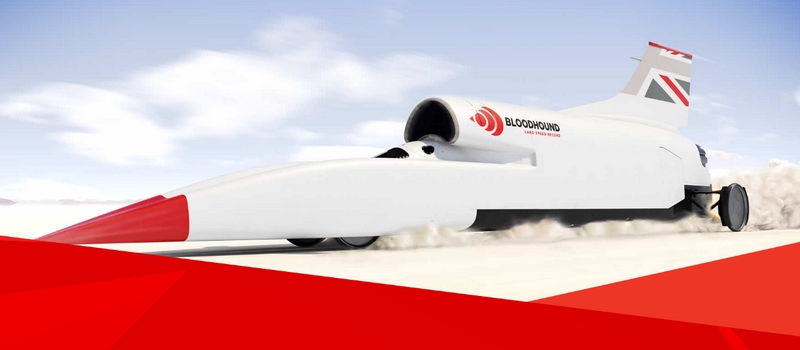A sleek machine that looks like a mash-up between a grandprix car, a fighter plane and a spaceship has undergone a final, ear-splitting test in the UK before being shipped to a desert in South Africa where it may eventually reach a speed of 1,000mph.
Over the past six months the Bloodhound LSR has taken shape in a workshop on a college campus in Gloucestershire and on Monday a “dry crank test” was carried out in which the car was powered up to confirm that the engine and systems had been correctly installed.
The roar of the engine could be heard throughout SGS Berkeley Green University Technical College and those who were nearby had to wear earplugs so as not to be overpowered by the din.
Bloodhound will now be carefully transported from its home on the banks of the River Severn to the Hakskeenpan in the Kalahari desert, where about 150 local people are clearing stones from a 12-mile test track.
In the next couple of months, the ambition is to drive the jet-powered car at more than 500mph – as fast as a commercial aircraft’s cruising speed. The team will analyse the data gathered during a series of runs and, in 12 to 18 months, will try to break the current land-speed record of 763.035mph – and then take the car past the 1,000mph mark.
At full design speed, Bloodhound could cover a mile in 3.6 seconds. Its solid aluminium wheels would spin at up to 10,200 rpm (revolutions per minute) – more than four times faster than wheels on a Formula One car at top speed.
Last year Bloodhound, which has been more than a decade in the making, looked to have hit a financial roadblock when the company previously behind the venture went into administration. It was saved at the last minute by a Yorkshire businessman, Ian Warhurst, and moved to its current base.
Warhurst admitted there had been times when he felt like tearing his hair out in frustration but it had all come together. “Something which has been talked about and planned for so long is now really happening,” he said.
Bloodhound is powered with a jet engine produced by Rolls-Royce and normally found on the Eurofighter Typhoon fighter jet – and a rocket system to give it a bit of extra poke.
The Bloodhound team say a key aim of the project is to inspire young people such as the students at Berkeley Green to become engineers, while trying to make the project as environmentally friendly as they can.
For the moment, they concede, they are using conventional jet fuel – one engineer described it as a “fire-breathing monster” – but are keen to find out, for example, if Bloodhound could run on biofuel.
Engineering director Mark Chapman said one of the main aims of this autumn’s trip was to test ways not only of making the car travel at great speed but making sure it could be stopped safely.
“The hardest thing is stopping before you run out of desert.” Two parachutes will be deployed to stop the car. If it doesn’t halt it will hit sand dunes – and then Namibia.
Chapman said he couldn’t wait to see the car put through its paces in the desert. “After many years in preparation, we can’t wait to get out to the Hakskeenpan and let Bloodhound off the leash to see just how it performs.”
guardian.co.uk © Guardian News & Media Limited 2010
Published via the Guardian News Feed plugin for WordPress.


